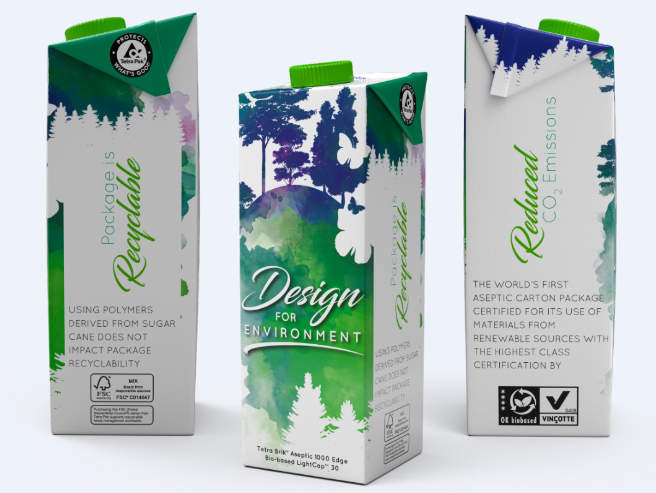

The value of a package means more to consumers than ever before. Due to increased awareness regarding environmental concerns and outrage at over-packaged items, the industry is paying very close attention to sustainable practices and finding ways to make packaging layers as recyclable as possible.
When thinking about sustainable approaches to packaging, three main drivers have caused this shift: climate change, population growth and resource depletion. We spoke To Tetra Pak to find out more about their new renewable aseptic packaging offering for liquids and what steps they are taking to produce a package that will one day be made from 100% renewable content.
The journey: where did it all begin?
In December last year, Tetra Pak announced the launch of a new version of their Tetra Brik® Aseptic (TBA) 1000 Edge with Bio-based LightCap™ 30 package. However, the journey of the TBA Edge began years before. In 2010, the company started to use paperboard from Forest Stewardship Council (FSC) Chain of Custody (CoC) certified sources for the TBA Edge. The certification means that wood fibres can be traced at every step through the supply chain, giving assurance that any product bearing the FSC logo supports forest management based on environmentally appropriate, socially beneficial and economically viable practices. The brand was then able to create a package with a renewable content value of 69%.
In 2011, the company created the first bio-based caps made from sugar cane and in 2012 the bio-based TBA Edge with LightCap 30 was launched with 74% renewable content. This then progressed to the creation of the first bio-based external layers.
Complex layers: the different components of a package have specific functions
The components in an aseptic carton package are more complex to ensure the product inside is protected. There are six different layers which all have a specific functionality. The metallocene/polyethylene layer is the second inside layer, while food grade polyethylene is the only material that touches the packed contents. Due to the excellent chemical resistant properties it possesses, this material is suitable for a wide range of food and beverage products, as it provides an extra sealing layer and helps to render the liquid inside the package secure and tight.
The adhesive polymer is the first inside layer and this provides adhesion. After this there is an aluminium foil layer, which blocks out light and oxygen to maintain the nutritional value and flavour of the packed product.
There is then a lamination layer comprised of low density polyethylene (LDPE), which provides a bond between the aluminium foil and the paperboard, followed by a duplex or bleached board layer, providing the package with stability and strength. Lastly is the décor layer – also made of LDPE – which shields the package from moisture on the outside, as well as protecting the print while making it possible to heat seal both the top and bottom flaps.
Omer Emran, global product manager, environmental innovations at Tetra Pak, said the company is working on changing the other layers to renewable materials in the future; however securing the material supply has been the main challenge.
“We need to secure a certain volume before asking the supplier to change from fossil to bio-based. There is a cost differential in producing bio-based material. But again you need to look at the value that the package is providing for a customer, and eventually to the consumers. Customers look at it as an investment in their brand to boost their KPIs and their commitment to sustainable product development,” Emran said.
Mario Abreu, vice-president environment at Tetra Pak, said the quantity and production of bio-based materials is currently on a very small scale in comparison to fossil fuels. In order to achieve a 100% renewable package, brands, manufacturers and suppliers will have to think about the long term. “They have to take into consideration that over time this will be a more competitive material. But right now it is very niche,” Abreu explained.
A new precedent: communicating with consumers
The TBA Edge is the first aseptic carton package in the world to receive the highest class of Vinçotte certification (the Belgium-based accreditation agency that is world-recognised for assessing the renewable content of packaging products) for its use of renewable materials. “Increasing the use of renewable materials, defined as natural resources that can be replenished over time, plays an increasingly important role in mitigating resource scarcity and climate change,” said Philippe Dewolfs, president of the certification committee at Vinçotte. “This is the only aseptic carton package we have certified so far and it has qualified for four-star certification.”
The new package is manufactured using a bio-based plastic film and cap, made from polymers derived from sugar cane. Combined with the paperboard, this lifts the share of materials from renewable sources in the package to above 80%, and the carton also boasts up to a 17% lower carbon footprint than a standard package, according to an independent lifecycle analysis conducted by IVL Swedish Environmental Research Institute.
Charles Brand, executive vice president, product management and commercial operations at Tetra Pak, said: “There is a growing trend that consumers want to do more for the planet, and they want brand owners to help. With the authentic certification from Vinçotte, our new package gives customers credible information to communicate with consumers, and helps them differentiate their products.
“Our ultimate goal is to produce all of our packages using only sustainably-managed renewable materials. Launching the new Tetra Brik Aseptic 1000 Edge with Bio-based LightCap 30 package is a significant milestone for us on that journey.”
The company have said that taking the next steps towards a 100% renewable aseptic package will be challenging, but that they will continue to forge ahead. This year the company aims to develop the opening at the neck, and within the next few years they will focus on the packaging material to introduce an alternative barrier, in addition to bio-based inks, which will edge them even further towards a fully renewable aseptic package.



